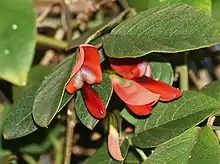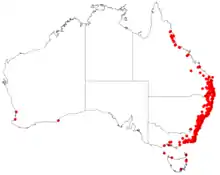Kennedia rubicunda
Kennedia rubicunda, commonly known as the dusky coral pea, is a species of flowering plant in the family Fabaceae, endemic to Australia. It occurs in the states of Victoria and New South Wales and Queensland.[4]
| Dusky coral pea | |
|---|---|
 | |
| Scientific classification | |
| Kingdom: | |
| (unranked): | |
| (unranked): | |
| (unranked): | |
| Order: | |
| Family: | |
| Subfamily: | |
| Tribe: | |
| Genus: | |
| Species: | K. rubicunda |
| Binomial name | |
| Kennedia rubicunda | |
 | |
| Australian occurrence data from Australasian Virtual Herbarium | |
| Synonyms[3] | |
|
Glycine rubicunda Schneev. | |
It is a vigorous climber with stems up to 4 metres (13 ft) in length and has oval-shaped leaflets in threes that are about 3–12 centimetres (1–5 in) long.[4] Dark red pea flowers are produced in racemes from late winter to spring (peaking from October to December)[5] and are followed by pods,[4] which are oblong 5–10 centimetres (2–4 in) long and 8–12 millimetres (0.3–0.5 in) wide, rusty and hairy, with 10–15 seeds to a pod.[6]
The species was first published in 1793 by Dutch botanist George Voorhelm Schneevoogt[7] under the later rejected name of Glycine rubicunda (Dingy-flowered Glycine) in Icones Plantarum Rariorum. In 1804 it was published under its current name by French botanist Étienne Pierre Ventenat in Jardin de la Malmaison.[1][2]
It is killed by bushfire and regenerates from seed dormant in the soil.[8]
Cultivation
This plant is noted for its vigour and can be used to cover embankments or structures.[9] The species is adapted to a range of well-drained soils and adapts to positions with sun or partial shade.[10] It is resistant to drought and has some frost tolerance.[10] The species can be propagated by scarified seed or cuttings of semi-mature growth.[10]
Weed status
It is an introduced species in India, Tasmania and the north island of New Zealand[3] (where it is considered a weed.[11])
References
- "Kennedia rubicunda". Australian Plant Name Index (APNI), IBIS database. Centre for Plant Biodiversity Research, Australian Government, Canberra. Retrieved 2008-09-25.
- Ventenat, E.P. (1805), Jardin de la Malmaison 2(18): 104, pl. 104 Retrieved 2 July 2018.
- Govaerts, R. et. al. 2018. "Plants of the World online: Kennedia rubicunda". Board of Trustees of the Royal Botanic Gardens, Kew. Retrieved 2 July 2018.
- "Kennedia rubicunda". PlantNET - New South Wales Flora Online. Royal Botanic Gardens & Domain Trust, Sydney Australia. Retrieved 2008-09-25.
- Morcombe, Michael (1991). Australia's Wildflowers (Réimpr. ed.). Sydney: The Book Company and Ure Smith Press. p. 26. ISBN 978-0725408732.
- VicFlora Flora of Victoria Kennedia rubicunda. Royal Botanic Gardens Foundation Victoria. Retrieved 02 July 2018.
- Schneevoogt, G.V. (1793), Icones Plantarum Rariorum 10: 28, pl. Retrieved 2 July 2018.
- Benson, Doug; McDougall, Lyn (1996). "Ecology of Sydney Plant Species Part 4: Dicotyledon family Fabaceae". Cunninghamia. 4 (4): 552–752 [623]. ISSN 0727-9620.
- Greig, D. (1987). The Australian Gardener's Wildflower Catalogue. Australia: Angus & Robertson. ISBN 978-0207154607.
- Bodkin, Frances (1991). Encyclopaedia Botanica. Australia: Cornstalk Publishing. ISBN 978-0207150647.
- NZ Flora Kennedia rubicunda (Schneev.) Vent. Retrieved 2 July 2018